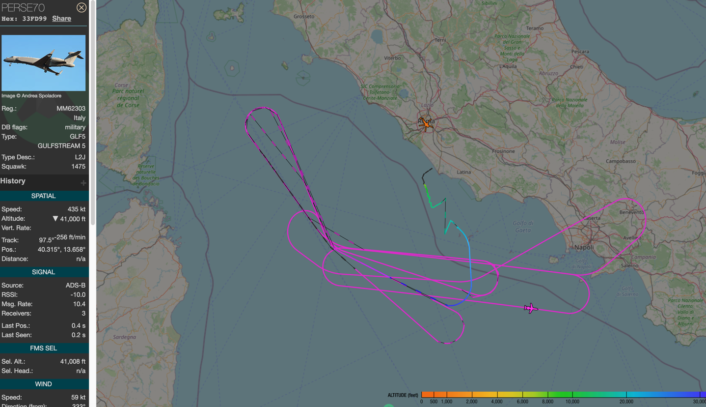The G20 summit is being held among tight security, involving several assets enforcing an ADIZ (Air Defense Identification Zone).
Many assets of the Aeronautica Militare are currently involved in a large operation required to ensure the security of the G20 summit, hosted by Italy, on Oct. 30 and 31, in Rome, and gathering several Heads of State and Prime Ministers.
Just to give you an idea of the aircraft that arrived at Rome for the summit, besides the Air Force One VC-25A and the accompanying SAM46 C-32A, the State Flights included, among all the others, the Korean B747-400, Indian B777, German Air Force A319, the Spanish A310, the Russian Il-96, Turkish A330, Argentinian A330, Royal Australian Air Force KC-30.
Here are just a couple of shots of the visitors; we will publish an article with the photographs of the most interesting ones in the next few days.


Restrictions on flight activities have been established beginning on Oct. 28 and ending at midnight on Nov. 1, 2021.
First of all, an ADIZ (Air Defense Identification Zone), with a radius of 75 NM from Rome, was implemented: all traffic that intends to operate inside the area, at any level, has to file a Flight Plan at least 2 hours earlier and operate with the assigned transponder mode. Within 35NM from Rome, VFR traffic is denied from Ground to FL175, while within 6.5NM from Rome, all traffic has been denied (except approved IFR flights from/to Fiumicino and Ciampino).
All the violations will cause a reaction by the Air Defense.
⚠️ Dalle 20.00 di oggi in vigore i divieti per #G20Roma:
– entro 75 NM FPL e identificazione;
– entro 35 NM divieto per VFR e droni;
– entro 6,5 NM divieto per tutto il traffico;
– limitate le operazioni sulle avio/elisuperfici del Lazio.
➡️ Dettagli: https://t.co/X3BgknXwFU pic.twitter.com/oXWo2KaHSY
— Desk Aeronautico (@DeskAeronautico) October 28, 2021
To that respect, the contingent put in place by the Italian Air Force includes two types of interceptors. For medium and fast aircraft, the Eurofighter Typhoons from Grosseto, Rivolto (where the F-2000As normally based at Istrana are operating these days because of works at their homebase), Gioia del Colle and Trapani are involved in H24 Combat Air Patrol, supported by both KC-767A and KC-130J tankers, inside R48, a restricted airspace located to the east of Rome: from there, the F-2000As (as the single-seat Typhoon are designated in Italy) could be dispatched to intercept an unknown or “renegade” aircraft much faster than any QRA (Quick Reaction Alert) fighter scrambled from its airbase.

For the slow movers (helicopters, light or ultralight aircraft, drones etc), the assets in CAPs at low level over downtown Rome are the HH-139 helicopters in SMI (Slow Mover Intercept) configuration. The Italian Air Force helicopters have been the only to fly over Rome alongside the ones of the Polizia (Police), Guardia di Finanza (Customs Police), Carabinieri (Military Police) and HEMS (Helicopter Emergency Medical Service).
Dealing with the Airborne Early Warning (AEW) and Information Superiority mission, a G.550 CAEW from Pratica di Mare has constantly provided air surveillance, command and control in cooperation with the Air Defense radars. An MQ-9 Predator has also been dispatched and constantly monitors the area where the Summit is held where the sensors of a P-72A have also been pointed. Belonging to the 41° Stormo (Wing) from Sigonella Air Base and flown by a mixed Air Force/Navy crew, the P-72A is a military variant of the ATR 72-600 that can undertake multiple roles: although it was born as a MPA (Maritime Patrol Aircraft), the P-72A is equipped with ESM (Electronic Support Measures) sensors along with a communication suite that enable the aircraft to collect data from signals it receives and transmit in real-time to/from command and control centres either on the ground, in the air or at-sea, to ensure coordinated and effective operations.
By the way, as already explained, although it is a multirole Maritime Patrol, Electronic Surveillance and C4I (Command, Control, Communications, Computers, and Intelligence) aircraft that shares many sensors and equipments which were developed for the ATR 72ASW developed by Leonardo for the Turkish Navy, the P-72A lacks an ASW (Anti-Sub Warfare) capability: for this reason it is considered a “gap filler” until the budget to procure a Long Range MPA with ASW capabilities will become available.
The participation of the P-72A in the G20 security mission was exposed by its Mode-S transponder that showed the aircraft orbiting over Rome on Oct. 29 for some hours, until the transponder was turned off.
This is cool. Italian Air Force P-72A operating inside restricted airspace for #G20Summit underway in Rome. You may ask: why is an ASW aircraft involved? Because of its ESM sensors pic.twitter.com/pmPpjcDq5Y
— David Cenciotti (@cencio4) October 29, 2021
Actually, other assets could be tracked online during the operation. Among them, the G.550 CAEW:

Noteworthy, C-UAS (Counter-Unmanned Air System) technologies were also deployed by the Italian Air Force to face the threat of small drones in areas surrounding the summit venue.









